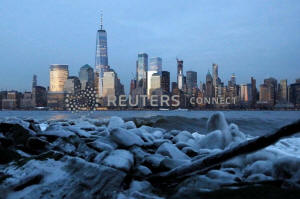|
In U.S. Midwest, 22F 'feels like spring'
after days of brutal cold
 Send a link to a friend
Send a link to a friend
 [February 02, 2019]
By Michael Hirtzer and Gina Cherelus [February 02, 2019]
By Michael Hirtzer and Gina Cherelus
CHICAGO/NEW YORK (Reuters) - Bone-chilling
cold that paralyzed a chunk of the United States this week and killed at
least 18 people eased on Friday as an errant Arctic air mass retreated
ahead of a warmer-than-normal weekend in areas of the Midwest and
Northeast.
In Chicago, where the mercury dipped as low as minus 22 Fahrenheit
(minus 30 Celsius) this week, temperatures of 22F (minus 5.5C) by Friday
afternoon felt balmy for some in the nation's third-largest city.
"It's got to be an almost 50 degree difference, it feels like spring,"
said one commuter heading home from Chicago's downtown financial
district, wearing only a sweatshirt.
Cable worker Brian Stachovic said he was up an electrical pole for only
five minutes on Thursday before his fingers and toes went numb, and he
had to go inside to avoid frostbite.
"Today, working outside it was like normal," said Stachovic, 40, wearing
brown overalls and insulated gloves, as he worked in Chicago's downtown.

Temperatures from southern New England to the upper Midwest should reach
the mid-40s to low 50s Fahrenheit through the weekend and Monday,
forecasters said, after a record-breaking cold snap that stopped mail
deliveries in some parts of the Midwest and shuttered schools and
businesses.
"The bitter cold air is going to be pushed up into Canada," said Bob
Smerbeck, senior meteorologist for Accuweather.
The Midwest's worst cold snap in two decades was created by the polar
vortex, a reservoir of icy air that usually swirls over the North Pole.
Shifting air currents caused it to slip down through Canada and into the
U.S. Midwest this week.
Temperatures on Friday afternoon ranged from the teens to the twenties,
after cities like Chicago experienced sub-zero temperatures for two days
and opened additional warming centers for the homeless.
DEATH TOLL MAY RISE
At least 18 deaths have been linked to the deep freeze since Saturday,
and the number was expected to climb as authorities identified more
victims.
[to top of second column]
|

Downtown Manhattan in New York City is seen over ice that formed on
the banks of the Hudson River during below freezing temperatures
from Jersey City, New Jersey, U.S., February 1, 2019. REUTERS/Andrew
Kelly

On Friday, police in East Moline, Illinois, about 160 miles (260 km)
west of Chicago, said the weather may have contributed to the death
of a FedEx freight driver whose body was found between two trucks on
Thursday outside a company distribution hub.
A representative for FedEx did not immediately respond to a request
for comment.
The Cook County's medical examiner's office said there were four
confirmed cold-related deaths this week in the Chicago area.
More than 40 cold-temperature records were broken on Thursday, the
coldest morning since the polar vortex moved in late on Tuesday,
clinging to a swath of the United States from Iowa and the Dakotas
across the Great Lakes region and into Maine.
Amtrak restored rail service to and from Chicago on Friday, and the
U.S. Postal Services resumed mail delivery in six Midwest states.
But while the U.S. Midwest and East Coast thawed out, a fierce
winter storm headed towards California, carrying heavy rains and
high winds that could touch off city flooding and mudslides.
(Reporting by Rich McKay in Atlanta and Gina Cherelus in New York;
additional reporting by Peter Szekely and Gabriella Borter in New
York, Michael Hirtzer in Chicago and Andrew Hay in New Mexico;
editing by Jonathan Oatis, James Dalgleish and Sonya Hepinstall)
[© 2019 Thomson Reuters. All rights
reserved.]
Copyright 2019 Reuters. All rights reserved. This material may not be published,
broadcast, rewritten or redistributed.
Thompson Reuters is solely responsible for this content.
 |